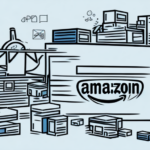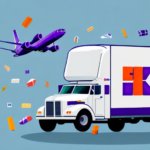Understanding UPS Returns Services: What You Need to Know
UPS Returns Services are an essential component of e-commerce businesses, allowing both sellers and customers to easily manage and track returns. In this article, we will explore the different aspects of UPS Returns Services and why they are important for businesses. We will also discuss how to set up and manage your business's returns process, including common challenges and best practices. Let's get started.
Why UPS Returns Services Are Important for E-commerce Businesses
With the rise of e-commerce, more and more businesses are relying on shipping services to deliver products to customers. However, returns are also an inevitable part of the process. According to a Statista report, approximately 20% of online purchases are returned. Customers may need to return products for various reasons, such as defects or incorrect orders, and businesses need a reliable system in place to accept and process these returns efficiently.
UPS Returns Services offer a streamlined process for managing returns. This includes pre-printed labels and return instructions that can be easily included in shipments, as well as tracking and monitoring capabilities for both the business and the customer. This not only improves the customer experience but also helps businesses manage their inventory and reduce costs associated with returns.
Another benefit of UPS Returns Services is the flexibility it offers to businesses. With multiple return options, such as drop-off locations or scheduled pickups, businesses can choose the most convenient method for their operations. Additionally, UPS Returns Services can be customized to fit the specific needs of each business, including branding and messaging on return labels and instructions.
Furthermore, UPS Returns Services provide businesses with valuable data and insights on their returns process. This includes information on the reasons for returns, the frequency of returns, and the locations of returns. By analyzing this data, businesses can identify areas for improvement in their products or processes, ultimately leading to a better customer experience and increased sales.
How to Set Up UPS Returns Services for Your Business
Setting up UPS Returns Services for your business is a straightforward process. You will need to create a UPS account and select the type of returns service that best fits your business's needs. There are a few different options available, including:
- UPS Returns® Plus
- UPS Print and Mail Return Label
- UPS Electronic Return Label
Once you select your service, you can easily integrate it into your existing shipping process. You can also customize your return instructions and labels to ensure a seamless and branded experience for customers.
One of the benefits of using UPS Returns Services is that it can help improve customer satisfaction. By offering a hassle-free returns process, customers are more likely to return to your business in the future. Additionally, UPS Returns Services can help reduce the workload on your customer service team, as customers can easily initiate and track their returns online.
Another advantage of using UPS Returns Services is that it can help you save money on shipping costs. With UPS Print and Mail Return Label, for example, you only pay for the label when it is used. This means that you can offer free returns to your customers without incurring additional shipping expenses.
What are the Different Types of UPS Returns Services?
As mentioned earlier, there are several types of UPS Returns Services available, each with its own unique benefits. Here is a brief overview of each:
UPS Returns® Plus
This is the most comprehensive service and offers a complete returns process, including pickup and transportation of the returned items. According to UPS, this service can reduce return processing time by up to 30%, enhancing overall efficiency.
UPS Print and Mail Return Label
This service allows you to create and print a return label for your customer, which they can use to send the item back to you. It provides flexibility and control over the return process, enabling businesses to manage returns without additional third-party services.
UPS Electronic Return Label
This service allows you to email your customer a return label, which they can print and use to return the item. It simplifies the return process by eliminating the need for physical labels and reducing paper usage.
It is important to note that UPS Returns Services also offer the option for customers to drop off their returns at a UPS location. This can be a convenient option for customers who may not be available for a pickup or do not have access to a printer to print a return label. Additionally, UPS Returns Services provide tracking information for both the merchant and the customer, ensuring transparency throughout the returns process.
Pros and Cons of Using UPS Returns Services for Your Business
While UPS Returns Services offer many benefits, there are also some potential drawbacks to consider. Here are some pros and cons:
Pros:
- Improves customer experience and satisfaction
- Streamlines returns process and reduces costs
- Offers tracking and monitoring capabilities
Cons:
- Requires upfront investment and ongoing fees
- May be less flexible than other return options
Ultimately, businesses must weigh these pros and cons to determine whether UPS Returns Services are the right fit for their needs.
It is important to note that UPS Returns Services may not be the best option for all businesses. For example, if a business has a very low volume of returns, the upfront investment and ongoing fees may not be worth it. Additionally, if a business requires a more flexible return policy, UPS Returns Services may not be able to accommodate those needs. According to a Business Report, evaluating return needs and comparing the costs and benefits of different options is crucial before making a decision.
How to Manage and Track UPS Returns as a Business Owner
Managing and tracking UPS Returns can be a fairly simple process, thanks to the tracking and monitoring capabilities offered by UPS Returns Services. You can easily track the progress of returns and communicate with your customers throughout the process. Here are some best practices for managing and tracking returns:
- Provide clear and detailed instructions for returns
- Monitor the status of returns and follow up with customers as needed
- Use tracking and monitoring tools to ensure timely and accurate returns
- Continually evaluate and improve your returns process
It is important to note that managing and tracking returns not only benefits the customer but also the business owner. By having a streamlined returns process, you can reduce the amount of time and resources spent on handling returns, and improve customer satisfaction and loyalty. Additionally, tracking returns can provide valuable insights into product quality and customer preferences, which can inform future business decisions.
Tips for Optimizing Your UPS Returns Process
To get the most out of UPS Returns Services, businesses can implement a few optimization tips. Here are some ideas:
- Offer incentives for customers who choose to use UPS Returns Services
- Use data and analytics to identify trends and opportunities to improve your returns process
- Provide personalized support and communication during the returns process
- Simplify the returns process as much as possible to reduce friction for customers
Another way to optimize your UPS Returns process is to provide multiple return options for customers. This can include drop-off locations, scheduled pickups, or even return labels included in the original shipment. By offering multiple options, customers can choose the method that is most convenient for them, which can lead to higher satisfaction and repeat business.
Additionally, it's important to regularly review and update your returns policy to ensure it aligns with customer expectations and industry standards. This can include clarifying return windows, outlining acceptable conditions for returns, and providing clear instructions for the returns process. By keeping your policy up-to-date and transparent, customers will feel more confident in their decision to use your business for their shipping needs.
Common Challenges Faced by Businesses When Using UPS Returns Services
While UPS Returns Services are designed to streamline the returns process, there are still some common challenges that businesses may encounter. These can include:
- Difficulty in managing a high volume of returns
- Communication and coordination issues with customers
- Logistical challenges, such as coordinating pickups and transportation
However, with the right systems and processes in place, these challenges can be minimized or eliminated altogether. Implementing automated tracking systems and clear communication channels can significantly reduce these issues.
How to Resolve Issues with UPS Returns as a Customer or Seller
If you encounter any issues with UPS Returns as a customer or seller, there are several steps you can take. As a customer, you can reach out to the seller to request a return label or troubleshoot any issues you may encounter. As a seller, you can contact UPS directly for support or refer to their online resources for guidance.
Understanding the Costs Associated with UPS Returns Services
UPS Returns Services do come with some costs, including upfront fees and ongoing charges. However, the specific costs will depend on the type of returns service you choose and your business's needs. Some businesses may find that the benefits of UPS Returns Services outweigh the costs, while others may need to evaluate their options to determine the most cost-effective solution. For a detailed breakdown of costs, refer to the UPS Returns Services pricing page.
Comparing UPS Returns to Other Shipping and Return Options
UPS Returns Services are just one option for managing returns. Other options include in-house returns processes, third-party providers, and other shipping carriers. When comparing options, businesses should consider factors like cost, convenience, and customer experience to determine the best fit for their needs.
According to industry analysis, partnering with a single carrier like UPS can simplify logistics but may limit flexibility compared to using multiple carriers or third-party solutions that offer specialized services.
Best Practices for Leveraging UPS Returns to Improve Customer Satisfaction
Finally, businesses can use UPS Returns Services to improve customer satisfaction. By offering a seamless and easy returns process, businesses can build trust with customers and foster long-term loyalty. Here are some best practices for leveraging UPS Returns Services to improve customer satisfaction:
- Create clear and simple return policies
- Provide prompt and responsive customer support
- Offer incentives for customers who choose to use UPS Returns Services
- Continually evaluate and optimize your returns process based on customer feedback
Case Studies: Successful Implementation of UPS Returns in E-commerce Businesses
There are many examples of businesses successfully implementing UPS Returns Services to improve their returns process and customer satisfaction. Here are a few case studies:
Case Study 1: Clothing Retailer
A clothing retailer implemented UPS Returns Services and saw a 60% reduction in the time it took to process returns. They also reported improved customer satisfaction and increased loyalty, leading to a 15% increase in repeat purchases.
Case Study 2: Electronics Retailer
An electronics retailer used UPS Returns Services to streamline their returns process and reduce costs associated with manual processing. They were able to save over $50,000 in the first year and saw an increase in customer satisfaction ratings by 25%.
Future Trends in the Evolution of UPS Returns Services
As e-commerce continues to grow, UPS Returns Services are likely to evolve and adapt to meet changing customer and business needs. Some potential future trends include:
- Increased automation and integration with other systems and processes
- Expanded use of artificial intelligence and machine learning for more efficient and accurate returns processing
- More personalized and streamlined returns experiences for customers
Staying ahead of these trends can help businesses maintain a competitive edge and continue to provide excellent customer service.
Conclusion
UPS Returns Services are a valuable tool for businesses looking to improve their returns process and customer satisfaction. By understanding the different services and best practices for implementation, businesses can streamline their returns process, reduce costs, and build trust and loyalty with customers. As e-commerce continues to evolve, UPS Returns Services will continue to play an important role in supporting businesses and customers alike.




















